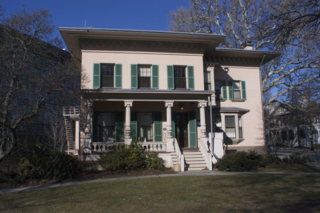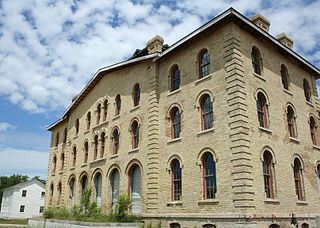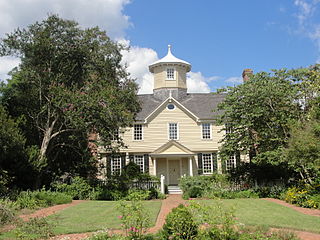
The Allen County Courthouse is located at the block surrounded by Clinton/Calhoun/Main/Berry Streets in downtown Fort Wayne, Indiana, the county seat of Allen County. Built between 1897 and 1902, it is a nationally significant example of Beaux-Arts architecture. It was listed on the National Register of Historic Places in 1976 and was designated a National Historic Landmark on July 31, 2003.

The Isaac Bell House is a historic house and National Historic Landmark at 70 Perry Street in Newport, Rhode Island. Also known as Edna Villa, it is one of the outstanding examples of Shingle Style architecture in the United States. It was designed by McKim, Mead, and White, and built during the Gilded Age, when Newport was the summer resort of choice for some of America's wealthiest families.

The Presbytère is an architecturally important building in the French Quarter of New Orleans, Louisiana. It stands facing Jackson Square, adjacent to the St. Louis Cathedral. Built in 1813 as a matching structure for the Cabildo, which flanks the cathedral on the other side, it is one of the nation's best examples of formal colonial Spanish architecture. It was designated a National Historic Landmark in 1970, and is now a property of the Louisiana State Museum.

The James Dwight Dana House, also known as the Dana House, is a historic 19th-century Italianate house at 24 Hillhouse Avenue in New Haven, Connecticut, in the United States. This building, designed by New Haven architect Henry Austin, was the home of Yale University geology professor James Dwight Dana (1813–95). It was declared a National Historic Landmark in 1965 for its association with Dana, who produced the first published works emphasizing that the study of geology was a much broader discipline than the examination of individual rocks.

Oakland Memorial Chapel is a historic church and academic building on the campus of Alcorn State University in rural southwestern Claiborne County, Mississippi. Built in 1838 as part of Oakland College, it is one of the oldest surviving buildings at Alcorn State, which took over that defunct school's campus after the American Civil War. Alcorn State was the first land grant university established specifically for the education of African Americans. The chapel was designated a National Historic Landmark in 1976, and was designated a Mississippi Landmark in 1985.

The Davis and Elkins Historic District is a National Historic Landmark District on the campus of Davis & Elkins College in Elkins, West Virginia. It includes two mansions, the Senator Stephen Benton Elkins House (Halliehurst) and Graceland, that are separately listed on the National Register of Historic Places. A gate house and an ice house are also included in the district. These four structures are associated with the families of Henry Gassaway Davis (1823-1916) and Stephen Benton Elkins (1841-1911), who were dominating figures in the politics and economy of West Virginia in the late 19th century. It was declared a National Historic Landmark in 1998.

The Wentworth-Gardner House is a historic mid-Georgian house, located at 50 Mechanic Street in Portsmouth, New Hampshire, United States. The house is operated as a museum by the Wentworth-Gardner Historic House Association. It is one of the finest extant examples of high-style Georgian architecture in New England, and played a role in the architectural preservation movement of the early 20th century. It was declared a National Historic Landmark in 1968.

Pemberton's Headquarters, also known as the Willis-Cowan House, is a historic house museum at 1018 Crawford Street in Vicksburg, Mississippi. Built in 1836, it served as the headquarters for Confederate General John C. Pemberton during most of the 47-day Siege of Vicksburg. It was also the site where Pemberton surrendered the city to U.S. Major General Ulysses S. Grant on July 4, 1863. The house is owned by the National Park Service and is open to the public as part of Vicksburg National Military Park. The house was declared a National Historic Landmark in 1976.

Stanton Hall, also known as Belfast, is an Antebellum Classical Revival mansion within the Natchez On-Top-of-the-Hill Historic District at 401 High Street in Natchez, Mississippi. Built in the 1850s, it is one of the most opulent antebellum mansions to survive in the southeastern United States. It is now operated as a historic house museum by the Pilgrimage Garden Club. The house was declared a National Historic Landmark in 1974; a pivotal property inside the Natchez On-Top-of-the-Hill Historic District in 1979; and a Mississippi Landmark in 1995.

The Dousman Hotel, is a historic hotel located at the intersection of Fisher Street and River Road in Prairie du Chien, Wisconsin. The hotel was built in 1864–65 to serve railroad and steamboat travelers coming to the city. The hotel was named after Hercules L. Dousman, an early Wisconsin fur trader, land speculator and millionaire.

The Farmers and Merchants Union Bank is a historic commercial building at 159 West James Street in Columbus, Wisconsin. Built in 1919, it is the last of eight "jewel box" bank buildings designed by Louis Sullivan, and the next to last to be constructed. It was declared a National Historic Landmark in 1976 for its architecture.

The Chowan County Courthouse is a historic courthouse in Edenton, the county seat of Chowan County, North Carolina. Built in 1767, it is one of the finest examples of public Georgian architecture in the American South. It was declared a National Historic Landmark in 1970.

Coolmore Plantation, also known as Coolmore and the Powell House, is a historic plantation house located near Tarboro, Edgecombe County, North Carolina. Built in 1858–61, the main house is one of the finest Italianate style plantation houses in the state. The house and its similarly styled outbuildings were designed by Baltimore architect E. G. Lind for Dr. Joseph J.W. and Martha Powell. Coolmore was designated a National Historic Landmark for its architecture in 1978, and is a Save America's Treasures projects.

The Cupola House is a historic house museum in Edenton, North Carolina. Built in 1756–1758, it is the second oldest building in Edenton, and the only known surviving example in the American South of a "jutt," or overhanging second floor. It was declared a National Historic Landmark in 1970.

The Octagon House, also known as May's Folly, is a historic octagon house at 527 1st Avenue in Columbus, Georgia. Built about 1830 and enlarged in 1863, it is claimed by the local historical society to be the nation's only known example of a double-octagon house. It was declared a National Historic Landmark in 1973.

The Old Medical College Building is a historic academic building at 598 Telfair Street in Augusta, Georgia, US. It was built in 1835 for the Medical College of Georgia, then and now one of the leading medical schools of the American South. It was declared a National Historic Landmark in 1996 for its sophisticated Greek Revival architecture, and for the role the school played in the establishment of the American Medical Association and the standardization of medical practices.
The National Register of Historic Places listings in Syracuse, New York are described below. There are 116 listed properties and districts in the city of Syracuse, including 19 business or public buildings, 13 historic districts, 6 churches, four school or university buildings, three parks, six apartment buildings, and 43 houses. Twenty-nine of the listed houses were designed by architect Ward Wellington Ward; 25 of these were listed as a group in 1996.

South Columbus Historic District is a historic district in Columbus, Mississippi that was listed on the National Register of Historic Places in 1982. Its 1980 nomination lists 525 structures and sites.

The U.S. Custom House, also known as the Old Post Office and Custom House, is a historic government building at 423 Canal Street in New Orleans, Louisiana. It was designated a National Historic Landmark, receiving this designation in 1974 and noted for its Egyptian Revival columns. Construction on the building, designed to house multiple federal offices and store goods, began in 1848 and didn't finish until 1881 due to redesigns and the American Civil War. The U.S. Customs offices have been located there since the late 19th century.

The Abner Davison House, also known as Riverview, is one of several mansions that overlook the Mississippi River on the east side of Davenport, Iowa, United States. It has been listed on the National Register of Historic Places since 1984, and on the Davenport Register of Historic Properties since 1997.





















